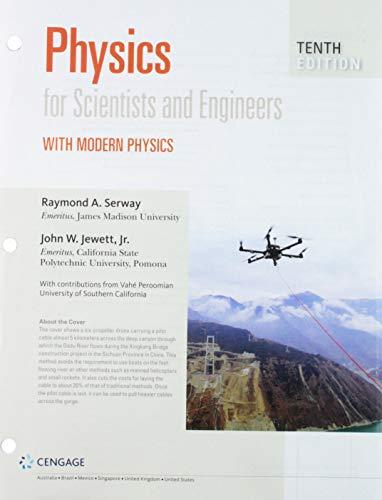
The classification of waves of frequencies
Answer to Problem 34AP
The classification of waves on the basis of frequency is shown below.
| Frequency,
|
Wavelength, | Classification | ||
|
|
| Radio | ||
|
|
|
Radio | ||
|
|
|
Radio | ||
|
|
|
Microwave | ||
|
|
|
Infrared | ||
|
|
|
Ultraviolet | ||
|
|
|
X-ray | ||
|
|
|
Gamma ray | ||
|
|
|
Gamma ray | ||
The classification of waves on the basis of wavelength is shown below.
| Wavelength, |
Frequency,
| Classification | ||
|
|
| Radio | ||
|
|
|
Radio | ||
|
|
|
Microwave | ||
|
|
|
Infrared | ||
|
|
|
Ultraviolet/ X-ray | ||
|
|
|
X-ray/Gamma ray | ||
|
|
|
Gamma ray | ||
|
|
|
Gamma ray | ||
Explanation of Solution
The formula to calculate the wavelength is,
Here,
Substitute
Substitute
Substitute
Substitute
Substitute
Substitute
Substitute
Substitute
Substitute
From the above calculation, the table for the wavelength can be deduces and the respective classification of waves is shown.
| Frequency,
|
Wavelength, | Classification | ||
|
|
| Radio | ||
|
|
|
Radio | ||
|
|
|
Radio | ||
|
|
|
Microwave | ||
|
|
|
Infrared | ||
|
|
|
Ultraviolet | ||
|
|
|
X-ray | ||
|
|
|
Gamma ray | ||
|
|
|
Gamma ray | ||
The formula to calculate the frequency is,
Here,
Substitute
Substitute
Substitute
Substitute
Substitute
Substitute
Substitute
Substitute
From the above calculation the table for the frequency can be deduces and the respective classification of waves is shown below.
| Wavelength, |
Frequency,
| Classification | ||
|
|
| Radio | ||
|
|
|
Radio | ||
|
|
|
Microwave | ||
|
|
|
Infrared | ||
|
|
|
Ultraviolet/ X-ray | ||
|
|
|
X-ray/Gamma ray | ||
|
|
|
Gamma ray | ||
|
|
|
Gamma ray | ||
Conclusion:
Therefore, the table of classification of waves with the frequencies is shown below.
| Frequency,
|
Wavelength, | Classification | ||
|
|
| Radio | ||
|
|
|
Radio | ||
|
|
|
Radio | ||
|
|
|
Microwave | ||
|
|
|
Infrared | ||
|
|
|
Ultraviolet | ||
|
|
|
X-ray | ||
|
|
|
Gamma ray | ||
|
|
|
Gamma ray | ||
Therefore, the table of classification of waves with the wavelengths is shown below.
| Wavelength, |
Frequency,
| Classification | ||
|
|
| Radio | ||
|
|
|
Radio | ||
|
|
|
Microwave | ||
|
|
|
Infrared | ||
|
|
|
Ultraviolet/ X-ray | ||
|
|
|
X-ray/Gamma ray | ||
|
|
|
Gamma ray | ||
|
|
|
Gamma ray | ||
Want to see more full solutions like this?
Chapter 33 Solutions
Bundle: Physics For Scientists And Engineers With Modern Physics, Loose-leaf Version, 10th + Webassign Printed Access Card For Serway/jewett's Physics For Scientists And Engineers, 10th, Single-term
 An Introduction to Physical SciencePhysicsISBN:9781305079137Author:James Shipman, Jerry D. Wilson, Charles A. Higgins, Omar TorresPublisher:Cengage Learning
An Introduction to Physical SciencePhysicsISBN:9781305079137Author:James Shipman, Jerry D. Wilson, Charles A. Higgins, Omar TorresPublisher:Cengage Learning Glencoe Physics: Principles and Problems, Student...PhysicsISBN:9780078807213Author:Paul W. ZitzewitzPublisher:Glencoe/McGraw-Hill
Glencoe Physics: Principles and Problems, Student...PhysicsISBN:9780078807213Author:Paul W. ZitzewitzPublisher:Glencoe/McGraw-Hill Principles of Physics: A Calculus-Based TextPhysicsISBN:9781133104261Author:Raymond A. Serway, John W. JewettPublisher:Cengage Learning
Principles of Physics: A Calculus-Based TextPhysicsISBN:9781133104261Author:Raymond A. Serway, John W. JewettPublisher:Cengage Learning
 University Physics Volume 1PhysicsISBN:9781938168277Author:William Moebs, Samuel J. Ling, Jeff SannyPublisher:OpenStax - Rice University
University Physics Volume 1PhysicsISBN:9781938168277Author:William Moebs, Samuel J. Ling, Jeff SannyPublisher:OpenStax - Rice University AstronomyPhysicsISBN:9781938168284Author:Andrew Fraknoi; David Morrison; Sidney C. WolffPublisher:OpenStax
AstronomyPhysicsISBN:9781938168284Author:Andrew Fraknoi; David Morrison; Sidney C. WolffPublisher:OpenStax





